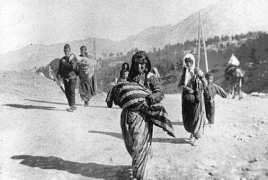
Rare, moving images of survivors of the 1915 Armenian Genocide will be shown in Bologna on Thursday as part of the 29th edition of the city's "Cinema Ritrovato" (Rediscovered Cinema) festival, AFP reports.
A significant historical source that was discovered completely by chance, buried away and forgotten in the U.S. Library of Congress, the silent film dates from 1923 and includes images of children packed onto boats in Turkey and lines of refugees trudging along roads.
The film is being shown as part of a selection intended to honour Armenian cinema a century after the beginning of the slaughter of Armenians at the hands of Ottoman Turkish forces.
Also on show during the festival are "Namus" (Honour), a 1925 work by Hamo Beknazarian that is considered the first Armenian film, "Sayat Nova" (The Color of Pomegranates) a 1969 film by Sergei Paradjanov and "Naapet", Henrik Malyan's 1980 film about a genocide survivor.
Other rare documentary images include a five-minute film shot by the French army of Armenian refugees in camps at Port Said in Egypt.
But the jewel in the festival's crown is the four minutes of "Armenia, Cradle of Humanity" shot in Turkey soon after the end of the killing - a time thought previously to have only been recorded in still images such as those of German photographer Armin Wegner.
Mariann Lewinsky, one of the festival's curators, came upon the film by "a miracle" as she clicked through the internet data base of the International Federation of Film Archives (FIAF).
Who shot the film and how it got to the Oregon Historical Society before being deposited in the Congress library is a mystery, says the Swiss researcher as she runs the recently-restored reel.

